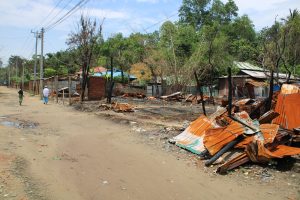The Arakan Army’s campaign against the State Administration Council (SAC) of the Myanmar military has triggered allegations of human rights abuses against the Rohingya Muslims in Rakhine State. The accusation against the rebel army gained traction when it began an offensive last April to capture the town of Buthidaung, near Myanmar’s northwestern border, from the military.
Videos of Rohingya Muslims, including women and children, fleeing in droves from Buthidaung went viral on social media, evoking memories of the atrocities committed on the community by the military in 2017, when over 700,000 Rohingya were compelled to relocate to Bangladesh. There were allegations that the Arakan Army ordered all Rohingya to leave after it entered the town on May 17, 2024.
The United Nations’ Office of the High Commissioner for Human Rights (OHCHR), in its September 2024 report on human rights violations in Myanmar, accused both the military and the Arakan Army of targeted attacks against civilians, particularly Rohingya, in and around Buthidaung. OHCHR noted reports of the intentional burning of homes and public buildings, firing on civilians, torture, and sexual violence.
The Arakan Army has flatly denied any attacks on civilians, including Rohingya, during its operation in Buthidaung. So too has the military. Yet homes were burned and eyewitnesses estimate dozens of civilians were killed.
What happened?
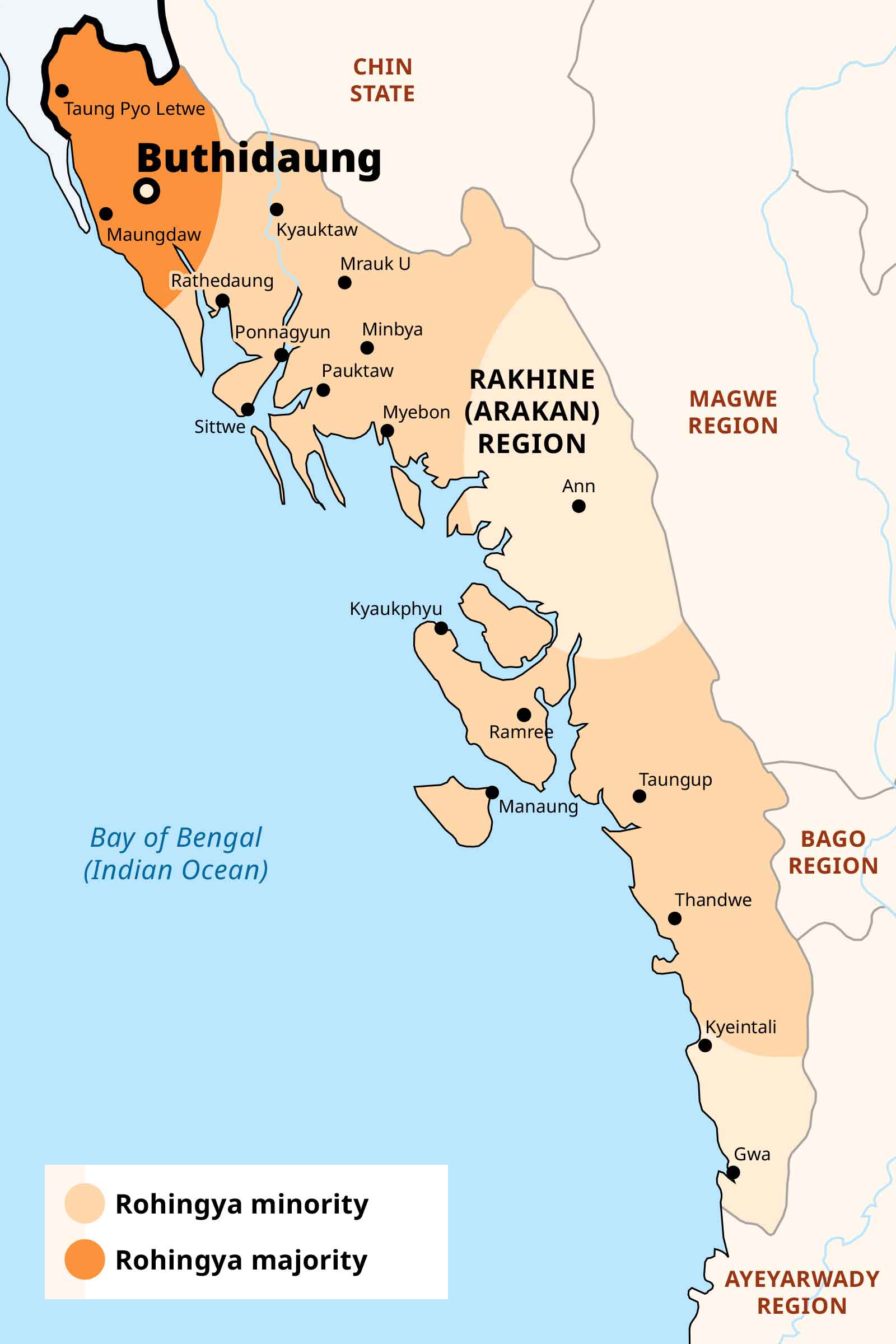
Buthidaung is located 96 kilometers northwest of the Rakhine State capital Sittwe and is part of Maungdaw district. Close to 70 percent of the populace in the township are Rohingya Muslims, 180,000 out of an estimated total of around 206,000. Rakhine Buddhists constitute about 25 percent of Buthidaung’s population and the rest are Khumi, Khamin, Mra, Chin, Dianet, and Bengali Hindus.
I was in Buthidaung for six days between June 20-25 for an investigation into the incidents in the township, with a focus on the town during the takeover by the Arakan Army. In addition to observing the situation in person, I interviewed a cross-section of people belonging to different communities, residents in three internally displaced person (IDP) camps, captured officers of the SAC, and functionaries of Arakan Army and its political front, the United League of Arakan.
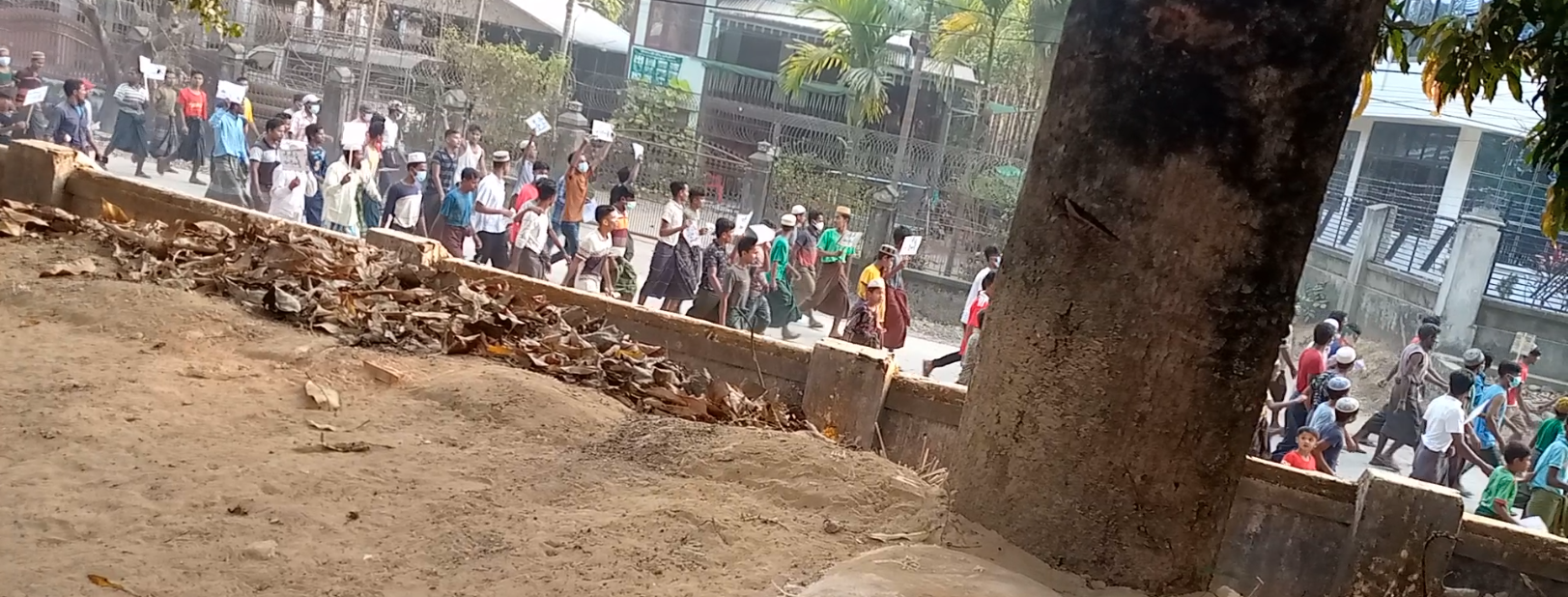
Screengrab of a video of protest march by a section of the Rohingya against the Arakan Army. Photo by Special Arrangement.
Before Buthidaung’s Seizure by the Arakan Army
The Arakan Army had already seized nine townships in a vast swathe covering southern Chin State and Rakhine State ahead of launching operations to capture Buthidaung from the Myanmar military. The military knew that it would not be able to defend the township against the rebel army, owing to a combination of many unfavorable factors. Captured Myanmar army Maj. Hlaing Win Tun, who was interviewed by this correspondent on June 24 in Buthidaung, revealed that the SAC troops suffered from diminishing resources, low morale, and lack of public support.
Consequently, the military joined hands with its former enemy, the Arakan Rohingya Salvation Army (ARSA), a Rohingya terror group, to achieve multiple objectives, including creating a militia of Rohingya youths for defending the township and triggering a communal flare-up against the non-Rohingya communities. Arakan Army functionaries claimed that the military also colluded with two more Rohingya terror groups – the Rohingya Solidarity Organization and Arakan Rohingya Army – but no evidence of the their activities was found in the township. (These two groups were reportedly active in and around Maungdaw town.)
The military’s plan to collaborate with ARSA was conceived after the Arakan Army launched a series of operations from November 13, 2023, as indicated by interviews with the captured police chief of the township Aung Kyaw Kyaw and functionaries of the rebel outfit. A series of meetings was held at Buthidaung and Maungdaw between military officers and senior functionaries of ARSA to fine-tune the plan. Hlaing Win Tun claimed that 750 Rohingya youths were recruited and trained for a few days during March and April at the military establishments in Buthidaung.
Before the plan was implemented, the military blew up the bridge contiguous to the town on the Kalar Panzurn Chaung (a tributary of Mayu river) to delay the advance of the Arakan Army.
Many among these Rohingya “recruits” – there are widespread reports of forced recruitment and coercion – escaped from the military centers and surrendered to the Arakan Army when the war was on in the neighboring areas of Buthidaung town. In interviews, they spoke about their experiences and how ARSA and the military were jointly involved in their forced recruitment and then the commission of crimes.
“We were instructed by the military to guard military outposts, burn houses of Rakhine Buddhists in the town, dig trenches, and erect bunkers. With us were ARSA functionaries in the operation and a few military personnel behind us who kept a strict watch on our activities,” recalled Hamidullah, who escaped and surrendered to the Arakan Army at a police station in the town.
Hamidullah’s account was confirmed by three other Rohingya recruits from different areas in Buthidaung – Mohammad Shali, Mohammad Junaid, and Mohammad Joha – who also escaped from the military. The account also matches with those of displaced residents belonging to the Khumi, Mra, and Hindu Bengali communities in the town and functionaries of the Arakan Army.
The military’s next step was to orchestrate protests by the Rohingya in Buthidaung town against the Arakan Army in order to fuel ethnic strife. The military presumed that the protests would spark riots between the Rohingya and other communities and stall the Arakan Army’s entry into Buthidaung town.
The same tactic was also adopted in other townships of Rakhine State. On March 22, thousands of protestors hit the streets in state capital Sittwe with slogans denouncing the Arakan Army. Rohingya activist Nay San Lwin alleged that the military had threatened to burn the houses of his community members and “expel them from the country” if they did not participate in the protests in Sittwe.
A group of four Rohingya clerics and teachers – Maulana Abdul Goni, Mohammad Noor, Abul Baser, and Ataullah – interviewed together on June 22 in Buthidaung explained that not everybody from their community participated in the protest marches in the town. They said that residents from some neighboring villages were motivated to take part in the program by ARSA and a section of the youths who were trained by the military. That residents from villages near the town were engaged in the violence was confirmed by captured police chief Aung Kyaw Kyaw.
A video of the procession that I obtained in Buthidaung showed a dozen blue colored mini-trucks ostensibly belonging to the military following the protesters, many of whom were raising slogans and holding placards. One vehicle was observed carrying a few protesters. It is possible that the vehicles were used to ferry residents from some neighboring villages to the town for the protest.
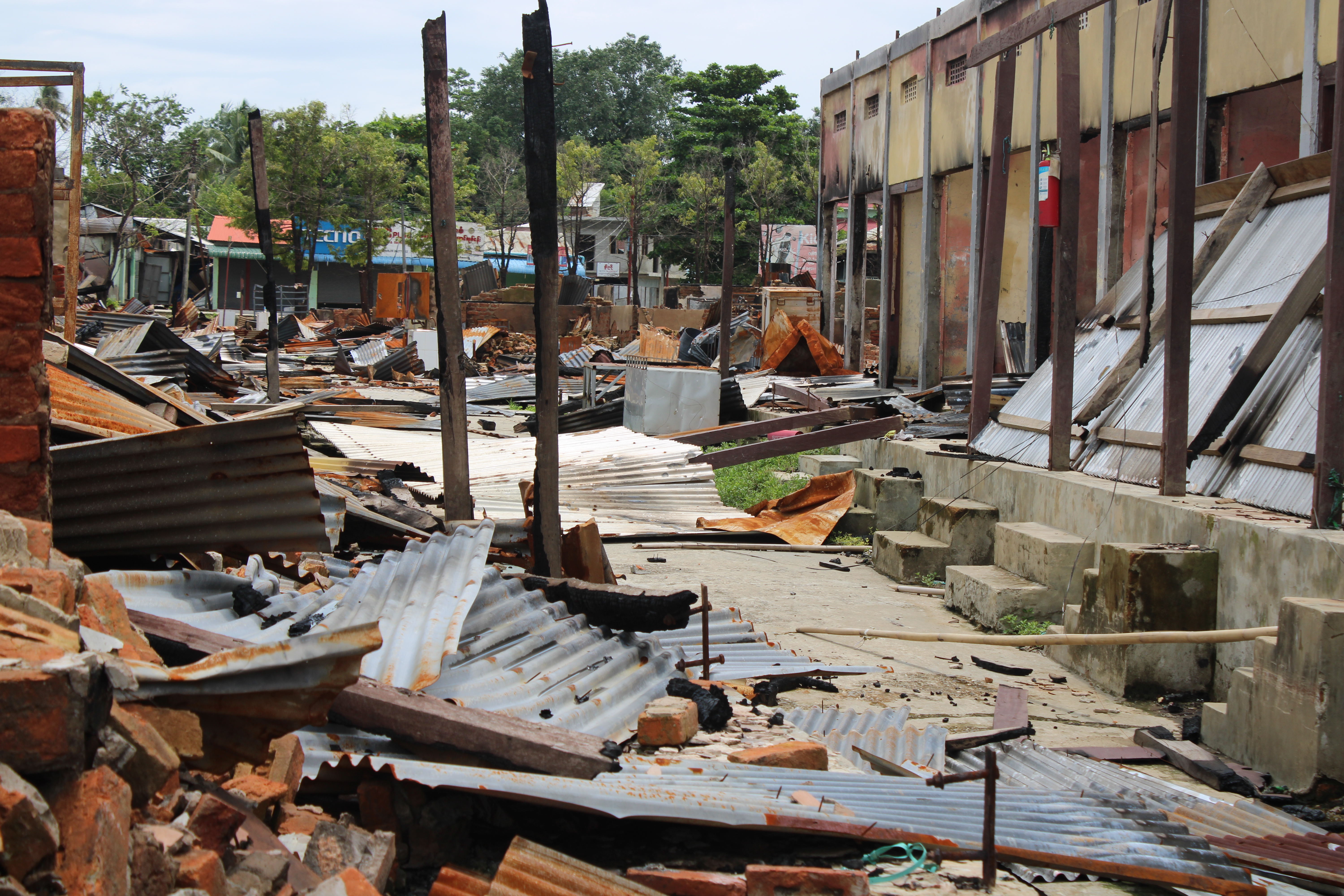
Burned houses in Ward 5 of Buthidaung town. Photo by Rajeev Bhattacharyya.
A Month of Arson, Plunder, and Killings
Some media reports in May highlighted widespread arson in Buthidaung Township when the Arakan Army was engaged in operations against the military. Satellite images were cited as evidence of the inferno that had engulfed large parts of the town. Aung Kyaw Moe, a Rohingya civil society activist and deputy minister in Myanmar’s shadow National Unity Government, told media that Rohingya residents were instructed by the Arakan Army to leave the town, but they responded saying that they had nowhere to go and so were trapped when the offensive started.
These reports referred to the situation in Buthidaung town, which was captured by the Arakan Army on May 18. The town proper is a small part of the township that has a total area of 2,225 square kilometers (859 sq miles approximately).
However, arson in the town commenced from April 12, and continued intermittently until about the second week of May. The worst affected zone in the town appeared to be Ward 4, where most of the houses were found burnt. Other areas in the town where charred houses were observed were Wards 3, 5, and 7. These houses belonged mostly to the Rakhine Buddhist community and a few to members of ethnic minorities such as Khamin, Khumi, Mra, and Hindu Bengalis.
Among the buildings that were found to be fully or partially burnt were facilities belonging to Medecins Sans Frontieres (MSF, also known as Doctors Without Borders), Action Contre La Faim (Action Against Hunger), and a church. A monastery was burnt and another betrayed signs of being ransacked and damaged.
Reverend Thar Yar Aung, who belongs to the Khamin community, recalled an irate mob coming to Ward 4, where he lived with residents of other communities, including Rohingya Muslims and Rakhine Buddhists. “A few families from our community decided to stay in the town despite knowing that the situation was deteriorating. Some Muslim neighbors [Rohingya] told us not to move out anywhere and we heeded their advice,” he said in an interview on June 23.
“On April 19, a mob of Muslims youths trained by the SAC came to our ward in three groups. First came the Muslims trained by the SAC, who ordered us to vacate the houses. The second group looted the property, and the third burnt the houses. Many of them identified themselves as ARSA,” he continued.
Similar to Thar Yar Aung’s narrative, a UNHCR report published on September 4 said that the “the military torched hundreds of ethnic Rakhine homes in Buthidaung town” in April 2024.
Most of these houses belonging to Rakhine Buddhists were unoccupied before being set aflame, as the occupants had relocated to safer zones in the township weeks ahead of the reign of terror in Buthidaung.
The houses were plundered in addition to being burnt. I stepped inside some of them, including partially burnt houses, only to find them empty and devoid of any items like furniture and cooking utensils usually found in a house. There was ample evidence that some of the looted items were stored in the houses of a few Rohingya residents in the town who had also participated in the plunder.
On May 19, a day after Buthidaung was completely seized by the Arakan Army, another Rohingya group opposed to ARSA and the plunder showed the Arakan Army all the houses where some of the looted commodities were stashed. The residents of these houses had already fled from the town, fearing retaliation. Some items were even buried and kept in underground cellars of the pillagers.
One video showed an entire wardrobe being dug out of the ground by Rohingya residents, with Arakan Army and United League of Arakan functionaries watching the exercise. I personally saw burgled items such as windows, doors, tin, and timber in two abandoned houses.
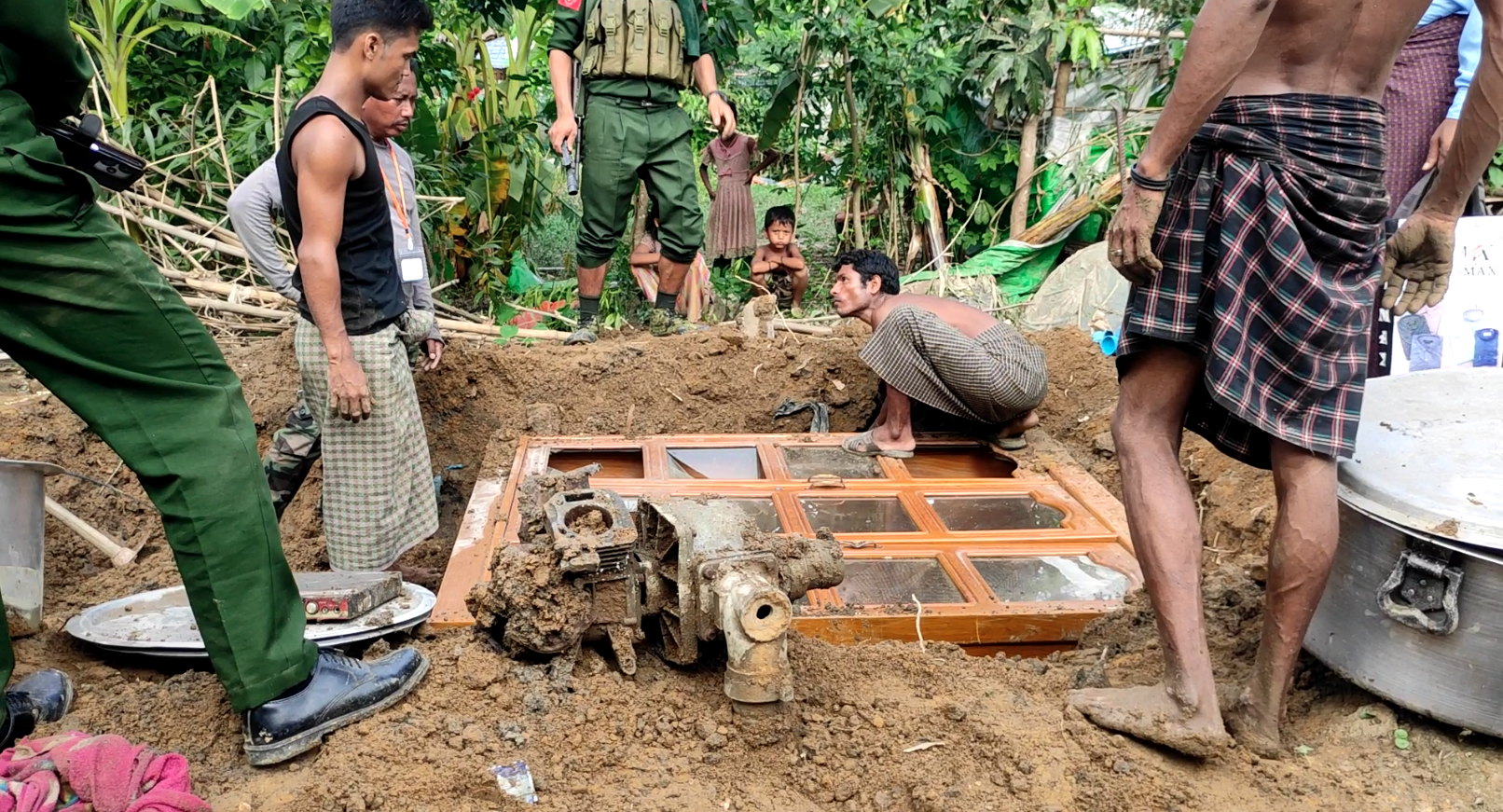
Screengrab of a video that recorded the recovery of stolen items from the house of a Rohingya resident on May 20. Photo by Special Arrangement.
There are differing estimates of the total number of houses burnt in Buthidaung. Than Win, a resident from Ward 5, opined that about 2,900 houses were burnt in the town, out of a total of 4,500. He claimed that most houses were set on fire between April 13 and 16 and again between April 24 and 29, after which the violence receded owing to the advance of the Arakan Army toward the town.
Two elderly residents at an IDP camp in the town and a functionary of United League of Arakan pegged the figure of burnt houses between 1,500 to 2,000. As per these estimates, approximately 60 percent of all houses in the town were charred.
However, wandering through the town conveys the impression that the percentage of burnt houses could be lower than the estimates given above. There were many empty wards in the town inhabited by the Rohingya that did not suffer any damage.
According to the data compiled by Humanitarian and Development Coordination Office (HDCO), a department under the United League of Arakan, 25 people, including 12 women, were killed in Buthidaung Township, out of a total of 194 in Rakhine State and Paletwa in southern Chin State, until May. But there was no separate data for Buthidaung town. The data compiled by the HDCO could not be independently verified.
According to some IDPs in the camps I visited and Arakan Army functionaries, at least 10 residents from non-Rohingya communities were either killed or remained missing from the town. Most of the missing persons were believed to have been detained by the military and then killed after being tortured at its establishments near the town.
Information gathered through interviews and informal chats seemed to indicate that most Rohingya residents who died hailed from areas outside the town, which witnessed pitched battles. They were killed while being caught in the crossfire or from the shelling in the conflict.
Roziya, a Rohingya woman in her mid-20s, narrated how her family members were killed after a shell hit their house in Krushong. “I narrowly escaped with my two children and husband since we were in a separate room but the other four [family] members died on the spot,” she recalled in an interview at the IDP camp in Mongnu Bazar on June 25.
Abdul Lafa, a middle-aged Rohingya man living at the IDP camp in Buthidaung town, claimed that at least 10 people were killed in shelling and airstrikes in their village Hpon Nyo Lake.
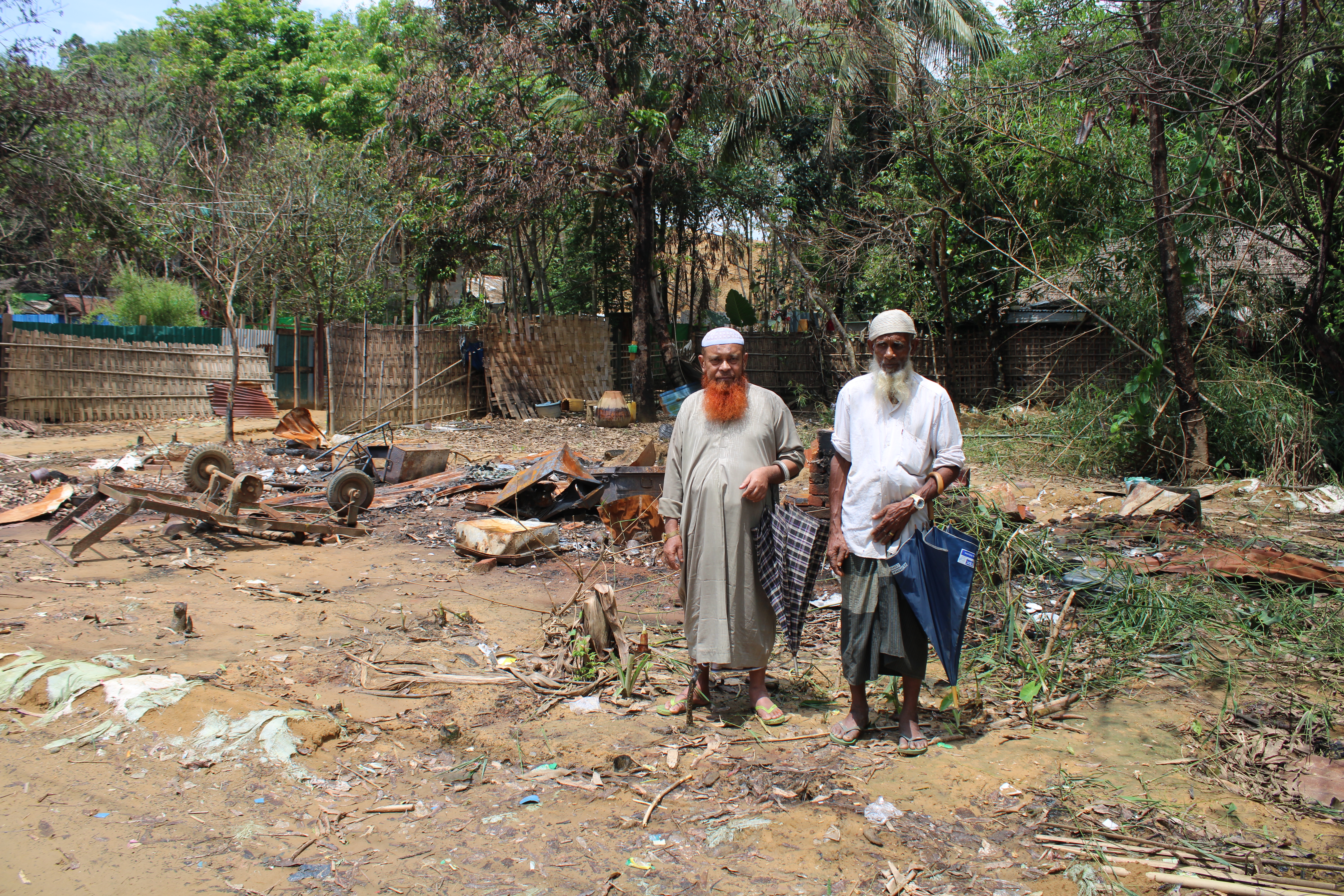
Burned houses of Rohingya residents in Buthidaung town. Photo by Rajeev Bhattacharyya.
Who Burned the Houses of the Rohingya?
The joint campaign by the junta’s forces and ARSA to stir up communal tensions by burning and looting the homes of Rakhine Buddhists and various ethnic minorities was readily confirmed by both Arakan Army functionaries and my own interviews. The question of arson attacks after the Arakan Army entered the town is more difficult to establish – in part because the Arakan Army continues to control access to Buthidaung.
The UNHCR report alleges that on May 17, “after driving the military from Buthidaung town, the Arakan Army set fire to buildings throughout the town, including Rohingya homes and public buildings where large numbers of Rohingya displaced by fighting in surrounding villages in the preceding weeks were sheltering.”
A separate analysis undertaken by the Australian Strategic Policy Institute (ASPI), based on satellite footage, noted the widespread arson of “predominantly Buddhist and Hindu neighborhoods of Buthidaung town,” which ASPI said was undertaken by “the military junta and Rohingya militants… to stoke further sectarian tensions.”
ASPI also accused the Arakan Army of “a systematic campaign of retaliatory arson [against the Rohingya] that has occurred in the township since 24 April and continued until at least 21 May.”
The Arakan Army strenuously denies these charges.
Among the burnt houses in Buthidaung town were about half a dozen belonging to the Rohingya. When I visited the locality on June 22, I found two elderly people in their 60s standing in front of an empty compound that was once home to a family. Fragments of charred items were scattered inside, indicating that it was an attack as awful as the incidents in the other zones of the town.
One of them identified himself as Husan Ahmed. He could understand and speak in Bengali and Urdu. A brief conversation with him revealed that all the houses were torched on May 17, which coincided with the day when the Arakan Army entered the town.
“Who burnt the houses?” I asked him.
“We have not seen. It happened at 12 am, at midnight. We ran from this spot. There were many people who came to attack,” he replied.
“But you must have some idea about the attackers.”
“No. We have not seen them. It was dark.”
It was evident that Ahmed was disinclined to provide precise answers to my questions. It was difficult to accept that he was unaware about the identities of the assailants. Clearly, he was reeling under fear – unlike the clerics and teachers and some IDPs in the town and at Mongnu Bazar, who were not hesitant to disclose information.
Lal Mia, a coordinator between the Rohingya and Arakan Army, claimed that the houses owned by the Rohingya “might have been burnt by SAC bombs through drones and bombing by aircraft.” His account tallied with the version of some senior functionaries of the United League of Arakan.
There were indeed spots and houses in the town that were hit by bombs. But the houses I saw exhibited definite signs of being torched, not bombed.
Abul Baser, a Rohingya teacher, pinned the blame on ARSA, saying many people from the community were on the “target list” of the outfit either for not supporting its cause or for refusing to donate funds to its kitty. “Some people did not escape from the town after it was taken over by the Arakan Army, [which] means that they have no fear of revenge attacks. So the needle of suspicion points at ARSA,” he claimed.
However, revenge attacks cannot totally be ruled out. There was a section of Rohingya residents in the town who were actively engaged with ARSA and the new recruits in burning and plundering the houses of the non-Rohingya people. And if there were indeed retaliatory arson attacks, then the victims have long since fled – no one I met in Buthidaung was willing to confirm this account.
Functionaries of the Arakan Army and United League of Arakan have vehemently denied engaging in revenge attacks against the Rohingya. “There is no reason for us to target civilians in townships that have already been liberated from the military. Efforts are on to involve all communities in the government that is being established in the liberated townships,” said Col.l Twan Yai, commander of Alpha 2 Military Region.
He added, “The news being circulated about ethnic cleansing by the Arakan Army is absolutely false, which you can verify yourself. But we will certainly not spare our enemies.”
Efforts to meet the residents of the burnt houses were unsuccessful. Ahmed claimed that he did not know where they had relocated, but he expected them to return after the green signal from the Arakan Army.
He also said that ARSA had been active in the area, but insisted “they did not come to this locality but to a place slightly far off from here.” And he denied that anyone from the neighborhood was affiliated with ARSA.
Evacuation from Buthidaung Town
Rebel outfits in Myanmar had made efforts on numerous occasions to evacuate the inhabitants of towns and cities before the start of a battle to avoid casualties and to deny the military the possibility of using civilians as human shields. There were many reports from different regions of the country claiming that the military had prevented civilians’ escape from conflict zones. Last month, the Arakan Army evacuated thousands of people from Maungdaw town and neighboring villages who were trapped in the fighting.
The evacuation from Buthidaung town and the contiguous areas had begun in the last week of March, when hectic preparations were on by the Arakan Army to capture the township from the military. “The residents in the town and other places that were expected to witness battles had been warned as early as March to shift to safer areas. Among the non-Muslim [non-Rohingya] communities, only the Hindu Bengalis decided to remain in the town,” said Aung Thaung Shwe, who has been appointed chief administrator of Buthidaung by United League of Arakan.
He explained that the Arakan Army had contacted a group of Rohingya in the second half of April to convince members of their community to exit from the town. Clerics, teachers, and elderly residents helped make announcements over loudspeakers urging evacuations in the third week of May.
The Arakan Army “had made an announcement through us with an appeal to all people to vacate the town. We gave the appeal through loudspeakers continuously for two hours. But some got stuck because the military and ARSA did not allow them to move out,” said Mohammad Noor, who was in the group that made the evacuation call.
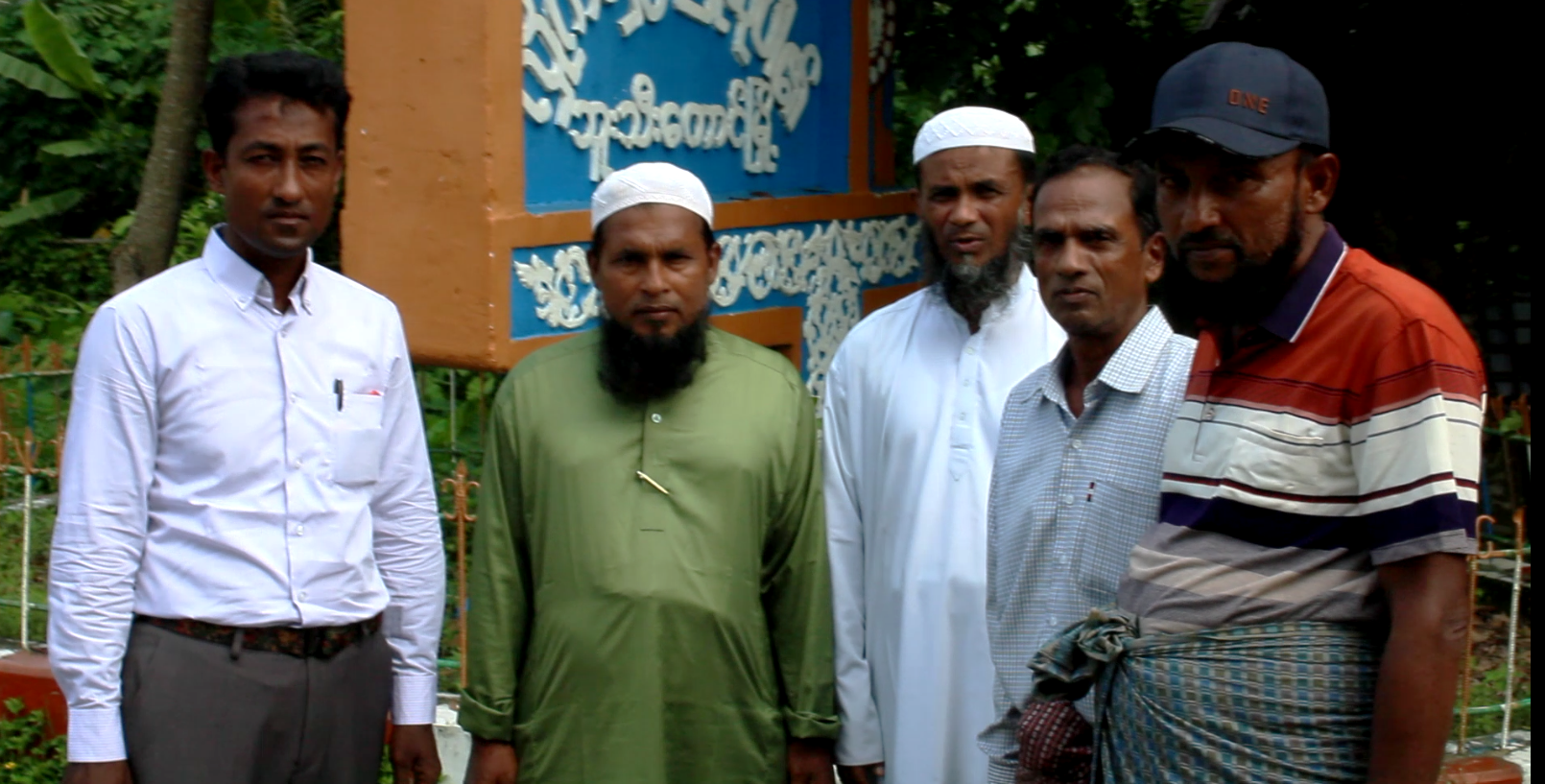
Rohingya clerics and teachers who made the announcement on May 17 calling for residents to evacuate from Buthidaung town. Photo by Rajeev Bhattacharyya.
The clerics and teachers reported being disgruntled with ARSA over the past few years primarily owing to its “unreasonable demands” for money and their policy of targeting the liberal and educated sections among the Rohingya. They felt that the situation for the community turned for the worse when the terror group collaborated with the military for a combined operation against the non-Rohingya civilians and the Arakan Army.
When asked the reason for their cooperation with the Arakan Army, these Rohingya teachers and clerics exuded hope of a “better future for the Rohingya in Myanmar” after the end of the SAC regime.
“Earlier, the Myanmar government had imposed severe restrictions on the Rohingya populace. Not only were we denied citizenship and passports but we were barred from traveling as well. Arakan Army has assured that there will be equal rights for all communities. There is no option but to be optimistic and support the Arakan Army,” Abul Baser said.

Hindu Bengali residents in Buthidaung town. Photo by Rajeev Bhattacharyya.
Not Everybody Fled From Buthidaung Town
Many residents in Buthidaung town refused to relocate despite the possibility of bombings, fierce gun battles, and the appeal from the Arakan Army. The Hindu Bengalis, comprising about 500 in the town, bore the brunt of the attacks by ARSA and the Rohingya recruits. As many as 47 houses were burnt and all valuable items, including cows and goats, were snatched. But they snubbed the appeal by the Arakan Army to move out from the town.
Sunil Mohan, a former school teacher, had a narrow escape from being killed by ARSA. He was hiding continuously for six months at different locations in the township. In an interview on June 23, he explained why he and fellow community members stayed: “We were apprehensive that all the houses would be burnt and everything stolen if we had shifted from the town. Residents from other communities in the town had relocated either to the homes of their relatives or other convenient places. We had no such facilities or arrangements.”
Besides the Hindu Bengalis, other residents who stayed included those living at two IDP camps in the town – one with about 100 IDPs belonging to non-Rohingya communities such as the Khumi, Khamin, Mra, and Rakhine Buddhists and the other of nearly 300 IDPs from the Rohingya community. The two camps were established in schools around 3 kilometers apart.
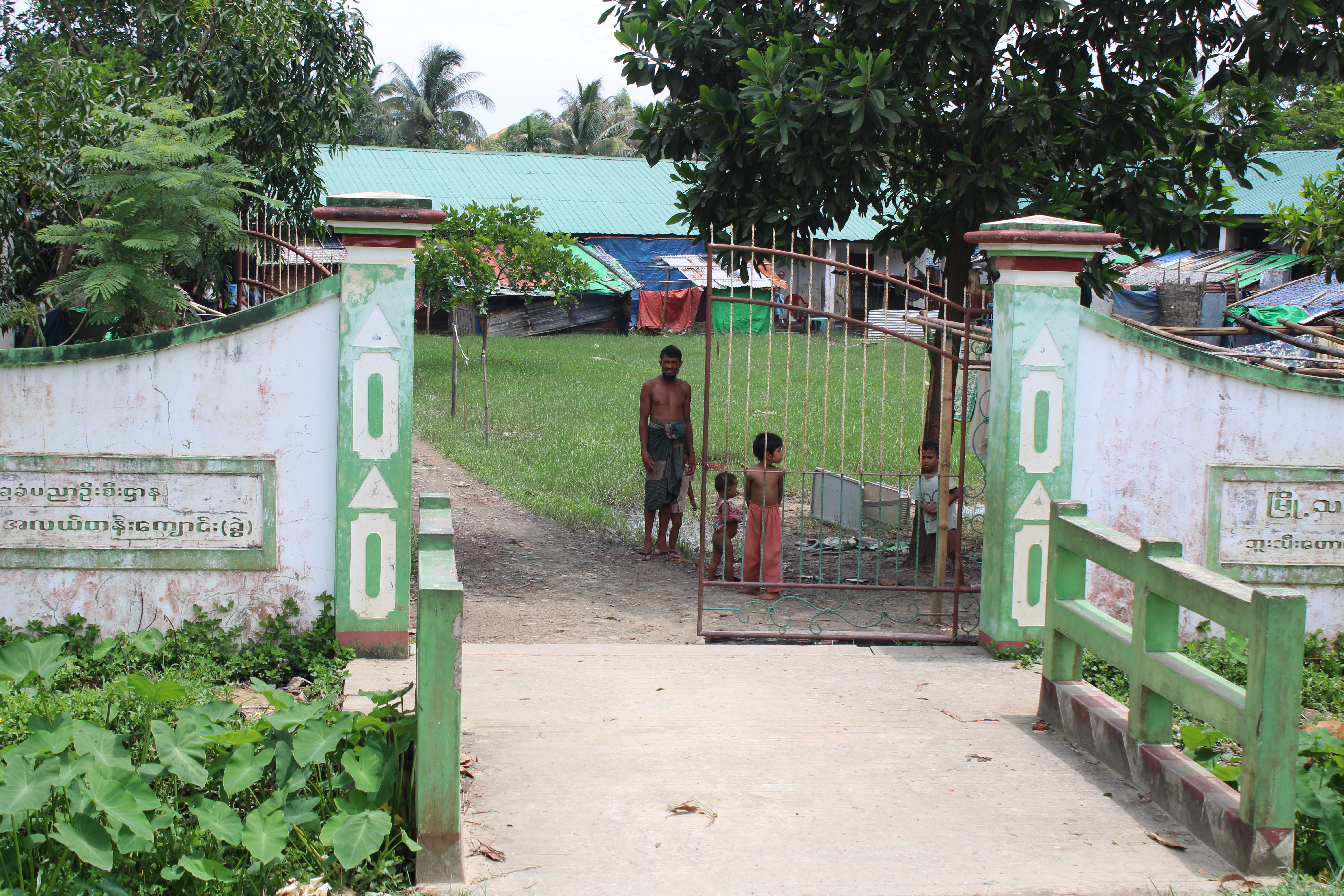
An IDP camp in Buthidaung town occupied by members of the Rohingya community. Photo by Rajeev Bhattacharyya.
In the first camp, there were many elderly and injured residents, some of whom were also suffering from ailments. It was difficult for them to relocate from the town, since it would have entailed walking for long distances. Than Tin Hlaing, 25, was a camp resident who had lost his right leg after he stepped on a landmine outside the town sometime in early February. He was left only with his parents to look after him as his five siblings were settled elsewhere. His father told me that Than Tin Hlaing was still recuperating from his injury, which scuttled any plan to relocate from the town. The Rohingya residents at the other IDP camp comprised residents from the town and a neighboring village, Hpon Nyo Lake.
As the fighting intensified, all the residents dispersed to different areas; a group of 41 people arrived at the camp in Buthidaung town.
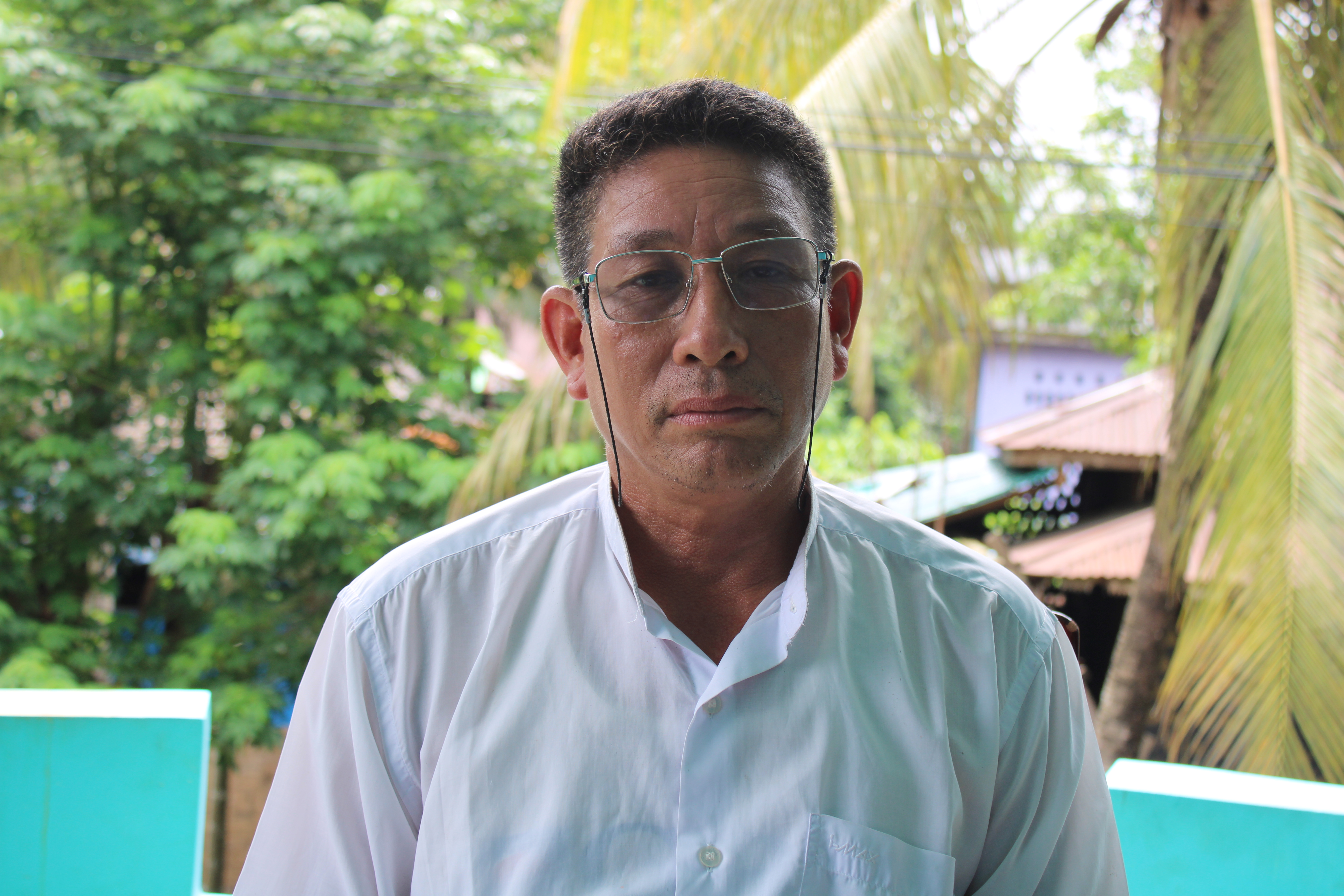
Buthidaung chief administrator Aung Thaung Shwe at his residence in the town. Photo by Rajeev Bhattacharyya.
“Resettlement of IDPs Will Begin Soon”
According to the HDCO data, Buthidaung tops the list among all the townships in Myanmar’s Rakhine State in terms of the number of displaced people. As of May, there were 142,379 reported IDPs, including 85,635 women, in the township. This includes the residents displaced from the town as well as people displaced due to Cyclone Mocha and before the war began in Rakhine State and southern Chin State. The total number of IDPs was 572,300 in 16 townships that had been occupied by the Arakan Army through May.
Chief administrator Aung Thaung Shwe, who was also a former member of Parliament from Rakhine State, engaged in long meetings with functionaries of the Arakan Army and United League of Arakan at his residence discussing the plan for repatriation of the IDPs to the town and the other zones in the township that were impacted by the conflict.
“Resettlement of IDPs in Buthidaung will begin soon. It is an extremely tough job necessitating a gamut of measures before the displaced people can be permitted to return to their homes,” he said. “First, we need resources to get the IDPs settled. Many IDPs don’t have houses and the infrastructure for sustenance. We will provide them with material support and seek assistance from global agencies.
“Second, village security committees would have to be formed that will be mandated with the task of security, monitoring the resettlement, and coordination with the United League of Arakan. But there will be no forced resettlement.”
Aung Thaung Shwe underscored the dire need of funds and medicines to complete the exercise. He explained that guidelines for the resettlement have been drafted that takes into account all aspects of the forthcoming exercise. Separate committees have been formed for the township, including the town proper, with members representing all the communities.
Resettlement in the “vulnerable zones” likely to face aerial attacks from the military would be delayed, Aung Thaung Shwe added.
Any locality, especially towns and cities, with a high population is susceptible to air raids by the military as evidenced from the attacks on other conflict zones where the military is on the back foot against the resistance groups. Buthidaung town has a high concentration of residents compared to other places in the township, which could make it an easy target of retaliation.
The United League of Arakan has not specified any timeframe for the resettlement in the town. It may take a while before all the displaced residents are allowed to return and can begin the long and arduous process of rebuilding their lives.













